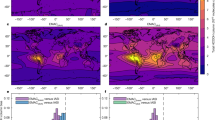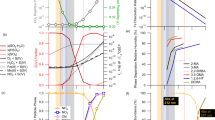Abstract
It is often assumed1–4 that the pH of natural rainwater is controlled by the dissociation of dissolved CO2, has a value of 5.6, and that decreases below this are due to the addition of acidic components by human activity. However, decreases could be due to the removal by rainwater of naturally occurring acids from the air (notably H2SO4 in the natural portion of the sulphur cycle). Consideration of the cycling of water and sulphate through the atmosphere and the amount and composition of sulphate aerosol expected to be scavenged by a given amount of cloud water in remote locations indicates that, in the absence of basic materials (such as NH3 and CaCO3), average pH values of ∼5 are expected to occur in pristine locations. This value must vary considerably due to variability in scavenging efficiencies as well as geographical patchiness of the sulphur, nitrogen and water cycles. Thus, pH values might range from 4.5 to 5.6 due to variability of the sulphur cycle alone. Because of widespread concern regarding the acidification of rain, it is important to understand the factors controlling the pH and composition of natural rainwater. We suggest here that there are integral constraints imposed by (1) the requirement for mass continuity in each elemental cycle and (2) the relative concentrations of soluble species and liquid water in cloudy air; these factors must be mutually consistent.
This is a preview of subscription content, access via your institution
Access options
Subscribe to this journal
Receive 51 print issues and online access
$199.00 per year
only $3.90 per issue
Buy this article
- Purchase on Springer Link
- Instant access to full article PDF
Prices may be subject to local taxes which are calculated during checkout
Similar content being viewed by others
References
Garrels, R. M. & MacKenzie, F. T. Evolution of Sedimentary Rocks (Norton, New York, 1971).
Galloway, J. N. Likens, G. E. & Edgerton, E. S. Science 194, 722–724 (1976).
Likens, G. E. & Bormann, F. H. Science 184, 1176–1179 (1974).
Likens, G. E. Bormann, F. H. & Johnson, N. M. in Some Perspectives of the Major Biogeochemical Cycles SCOPE Rep. 17 (ed. Likens, G. E.) (Wiley, Chichester, 1981).
Hallberg, R. O. in Nitrogen, Phosphorus and Sulphur–Global Cycles SCOPE Rep. 7, (eds Svensson, B. H. & Söderlund, R.) 93–101 (Swedish Natural Science Research Council, 1976).
Granat, L. in Nitrogen, Phosphorus and Sulphur—Global Cycles SCOPE Rep. 7 (eds Svensson, B. H. and Söderlund, R.) 102–122 (1976).
Nguyen, B. C. Gaudry, A. Bonsang, B. & Lambert, G. Nature 275, 637–639 (1978).
Hansen, M. H., Ingvorsen, K. & Jørgensen, B. B. Limnol. Oceanogr. 23, 68–76 (1978).
Cadle, R. D. J. geophys. Res. 80, 1650–1652 (1975).
Friend, J. P. in Chemistry of the Lower Atmosphere (ed. Rasool, S. I.) 177–201 (Plenum, New York, 1973).
Cullis, C. F. & Hirschler, M. M. Atmos. Envir. 14, 1263–1278 (1980).
Rodhe, H. & Isaksen, I. J. geophys. Res. 85, 7401–7409 (1980).
Eriksson, E. Tellus 12, 63–109 (1960).
Rodhe, H. Atmos. Envir. 12, 671–680 (1978).
Rodhe, H. in Nitrogen, Phosphorus and Sulphur—Global Cycles SCOPE Rep. 7 (eds Svensson, B. H. & Söderlund, R.) 123–128 (Swedish Natural Science Research Council, 1976).
Galloway, J. N. & Whelpdale, D. M. Atmos. Envir. 14, 409–418 (1980).
Taylor, G. S. Baker, M. B. & Charlson, R. J. in Interaction of the Biogeochemical Cycles (eds Bolin, B. & Cook, R.) (Wiley, London, 1982).
Duce, R. A. Biogeochemical Cycles and the Air/Sea Exchange of Aerosols (Wiley, London, 1982).
Sillén, L. G. in Equilibrium Concepts in Natural Water Systems Adv. Chem. Ser. no. 67, 45–56 (American Chemical Society, Washington DC, 1967).
Junge, C. E. Air Chemistry and Radioactivity (Academic, New York, 1963).
OECD. The OECD Programme on Long Range Transport of Air Pollutants, Measurements and Findings (Organization for Economic Cooperation and Development, Paris, 1977).
Fletcher, N. H. The Physics of Rain Clouds (Cambridge University Press, 1962).
Slinn, W. G. N. et al. Atmos. Envir. 12, 2055–2087 (1978).
Scott, B. C. J. appl. Met. 20, 619–625 (1981).
Maroulis, P. J. Torres, A. L. Goldberg, A. B. & Bandy, A. R. J. geophys. Res. 85, 7345–7349 (1980).
Garland, J. A. Q. J. R. met. Soc. 97, 483 (1971).
Lawson, D. R. & Winchester, J. W. Science 205, 1267–1269 (1979).
Huebert, B. J. & Lazrus, A. L. J. geophys. Res. 85, 7337–7344 (1980).
Bonsang, B. Nguyen, B. C. Gaudry, A. & Lambert, G. J. geophys. Res. 85, 7410–7416 (1980).
Bolin, B. et al. Air Pollution Across National Boundaries ; The Impact on the Environment of Sulfur in Air and Precipitation (Royal Ministry for Foreign Affiairs, Stockholm, 1971).
Drabløs, D. & Tollan, A. Ecological Impact of Acid Precipitation; Proceedings of an International Conference (SNSF, Ås, Norway, 1980).
Granat, L. Atmos. Envir. 12, 413–424 (1978).
NOAA. Geophysical Monitoring for Climatic Change No. 7 (National Oceanic and Atmospheric Administration, Boulder, Colorado, 1979).
Kerr, R. A. Science 212, 1014 (1981).
Larsen, T. V. & Harrison, H. Atmos. Envir. 11, 1133–1141 (1977).
Author information
Authors and Affiliations
Rights and permissions
About this article
Cite this article
Charlson, R., Rodhe, H. Factors controlling the acidity of natural rainwater. Nature 295, 683–685 (1982). https://doi.org/10.1038/295683a0
Received:
Accepted:
Issue Date:
DOI: https://doi.org/10.1038/295683a0
This article is cited by
-
Monitoring of rainwater quality in Kandy and Peradeniya, Sri Lanka
Environmental Monitoring and Assessment (2024)
-
Water-soluble photoluminescent carbon dots prepared from phloroglucinol by catalyst- and solvent-free reaction
Carbon Letters (2023)
-
Wet deposition of total nitrogen, dissolved organic carbon and heavy metals investigating role of long-range transport at two sites in Delhi
Journal of Atmospheric Chemistry (2023)
-
Ionic Compositions of Sequential Rainfall Samples as Source Signatures of Forest Fire Emissions
Chromatographia (2023)
-
Seven-year study of monsoonal rainwater chemistry over the mid-Brahmaputra plain, India: assessment of trends and source regions of soluble ions
Environmental Science and Pollution Research (2022)
Comments
By submitting a comment you agree to abide by our Terms and Community Guidelines. If you find something abusive or that does not comply with our terms or guidelines please flag it as inappropriate.



